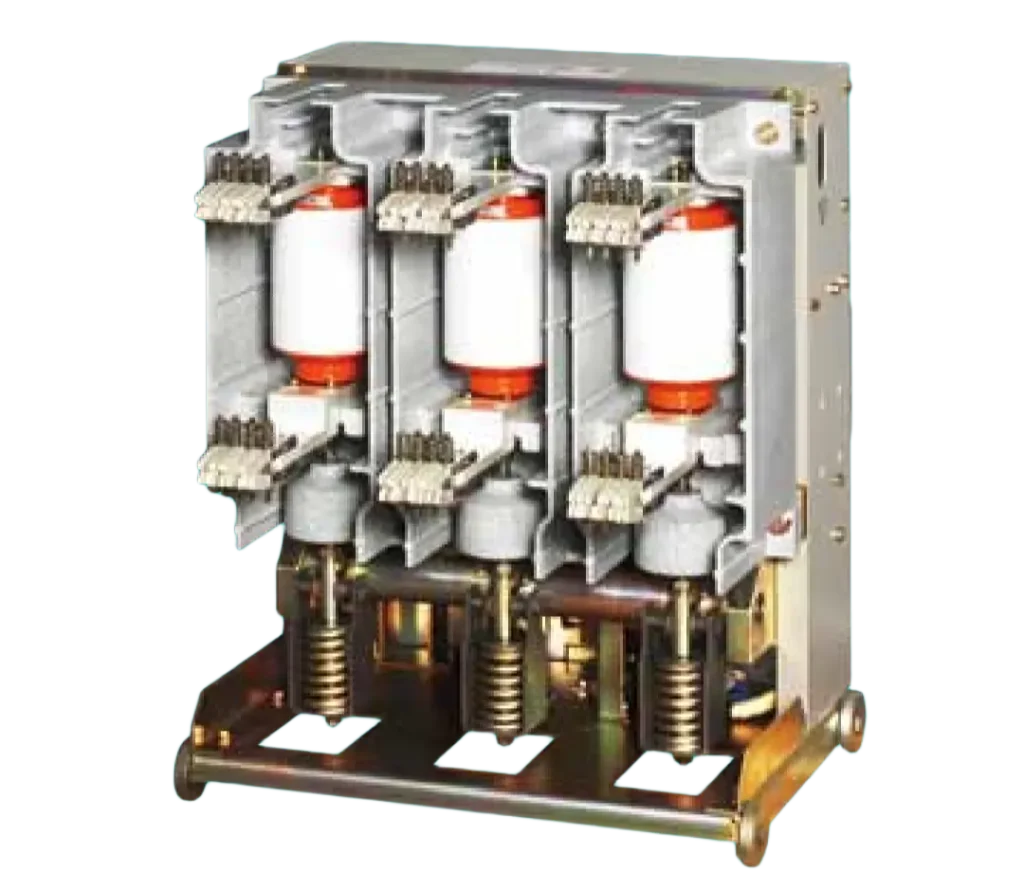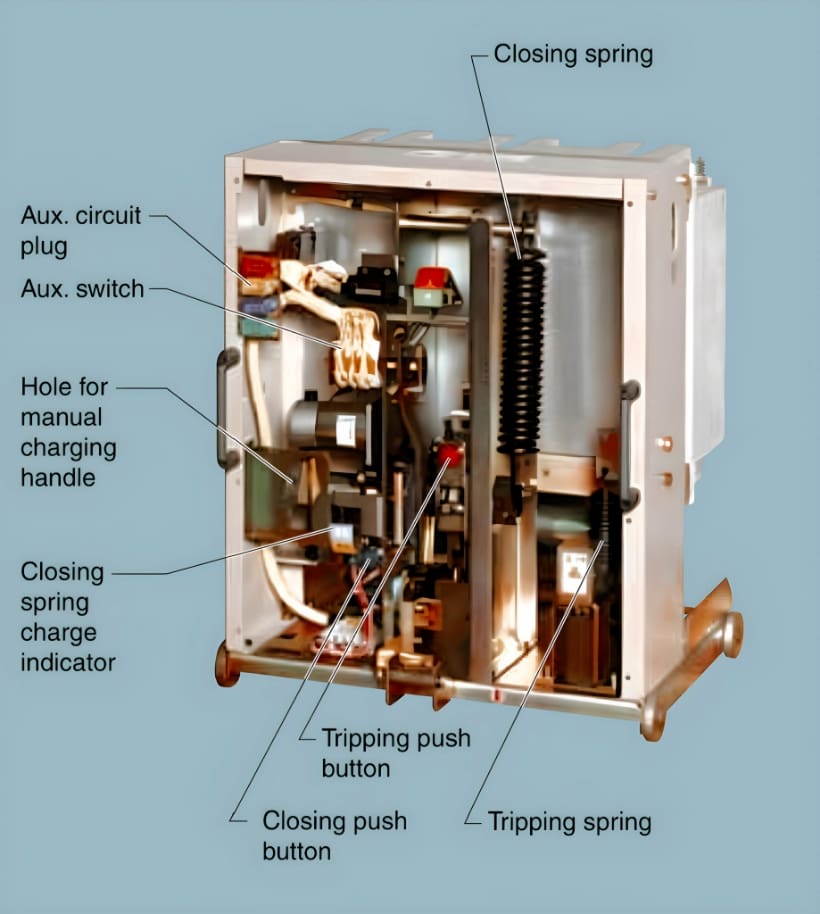VCB: Working Principle, Construction, Advantages
A vacuum circuit breaker (VCB) is an electrical switch designed to interrupt an electric current in a vacuum medium. It uses the principle of vacuum arc extinction to extinguish the arc generated during the circuit breaking process. VCBs find applications in various industries and power distribution networks due to their numerous advantages over other types of circuit breakers.
One of the most significant advantages of using a vacuum medium is its ability to quickly extinguish the arc. The dielectric strength of the vacuum improves rapidly once the arc is generated, making it possible to achieve arc extinction within a short period. The vacuum interrupter’s design plays a crucial role in maintaining the vacuum pressure, typically around 10^-6 bar, to ensure optimal performance.

Construction of Vacuum Circuit Breaker

Vacuum Interrupter
The heart of a VCB is the vacuum interrupter, which consists of two metal contacts enclosed in a vacuum chamber. The contacts are designed to withstand the high voltage and current during switching operations.
Arc Quenching Mechanism
The VCB’s arc quenching mechanism is responsible for extinguishing the arc generated between the contacts when the circuit breaker is opened. In a vacuum circuit breaker, the arc quenching relies on the rapid increase in resistance of the arc as it stretches and deionizes the vacuum, resulting in arc extinction.
Operating Mechanism
The operating mechanism of a VCB is responsible for the opening and closing of the contacts. It typically uses a spring-loaded mechanism combined with a motor or manual control for efficient operation.
Insulating Structure
The insulating structure of a VCB ensures that the high voltage does not leak into the surrounding environment. It consists of ceramic or epoxy resin insulators that provide excellent insulation properties.
Working Principle VCB
The vacuum circuit breaker working principle is that during normal operation, the contacts of a vacuum circuit breaker remain closed, allowing the flow of current. When a fault occurs or a circuit needs to be isolated, the VCB interrupts the current by rapidly opening its contacts. This action initiates the arc between the contacts.
The arc is produced due to the ionization of metal ions and depends on the contact material. As the contacts separate, vapor is released into the contact space. This vapor consists of positive ions liberated from the contact material. The density of the vapor depends on the current flowing through the arc. As the current decreases, the vapor release rate decreases, allowing the dielectric strength of the medium to recover.
In a vacuum circuit breaker, the arc is divided into multiple parallel paths when the current to be interrupted is small. These parallel arcs repel each other and spread over the contact surface, forming a diffused arc that can be easily interrupted. However, at high current values, the arc becomes concentrated in a small region, causing rapid vaporization of the contact surface. To ensure interruption, the arc must remain diffused. If the arc is quickly removed from the contact surface, re-striking may occur.
Arc extinction in vacuum circuit breakers is influenced by the contact material, contact shape, and the technique used to handle metal vapor. The arc’s path is deliberately kept moving to prevent high temperatures at any single point. After the final arc interruption, the dielectric strength rapidly increases, making vacuum circuit breakers suitable for capacitor switching. The interruption of small currents occurs before the natural current zero, which may result in some level of current chopping.
Current Chopping
Current chopping refers to the interruption of current flow in a circuit breaker before the natural current zero, mainly occurring in oil circuit breakers and air circuit breakers due to the instability of the arc column. In vacuum circuit breakers, current chopping primarily depends on the vapor pressure and electron emission properties of the contact material. The chopping level is influenced by the thermal conductivity of the contact material, with lower thermal conductivity resulting in lower chopping levels.
To reduce the chopping level, contact materials can be selected to provide ample metal vapor, allowing the current to approach extremely low values. However, this approach can negatively impact the dielectric strength of the vacuum. Therefore, a balance must be struck to ensure both efficient interruption and satisfactory dielectric performance.
After the arc is extinguished, the operating mechanism ensures that the contacts are held open until the fault condition is cleared or the circuit is manually reset. Once the fault is eliminated, Contacts can be closed again to restore the flow of current.
Advantages of VCB
- High Breaking Capacity: VCBs offer high breaking capacity, allowing them to interrupt large currents without damaging the contacts.
- Quick Operation: Vacuum circuit breakers have a fast operating speed, enabling them to interrupt the circuit within microseconds, minimizing damage to electrical equipment.
- Low Maintenance: Require minimal maintenance due to the absence of any medium for arc quenching. This reduces the downtime and cost associated with maintenance activities.
- Environmentally Friendly: VCBs do not use any hazardous substances, making them environmentally friendly alternatives to other circuit breaker types.
Disadvantages of Vacuum Circuit Breakers
- Limited Current Ratings: they have limited current-carrying capacity compared to other types of circuit breakers, making them unsuitable for applications with extremely high current levels.
- Higher Cost: Vacuum circuit breakers tend to have a higher initial cost than other circuit breaker types, which may be a consideration in certain applications.
Applications of Vacuum Circuit Breaker
- Power Generation Plants: Commonly used in power generation plants to protect generators, transformers, and high voltage transmission lines.
- Industrial Sector: Find applications in the industrial sector to protect electrical equipment such as motors, transformers, and capacitors.
- Electrical Distribution Networks: Widely used in medium and high voltage electrical distribution networks to ensure the safe and reliable supply of electricity.
In conclusion, vacuum circuit breakers provide efficient and reliable circuit interruption capabilities in various applications. Their high breaking capacity, quick operation, and low maintenance make them a preferred choice for many industries and power distribution systems, despite their limitations in current ratings and higher initial cost.